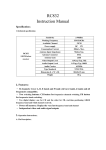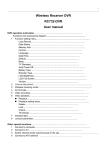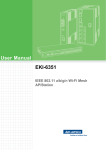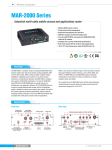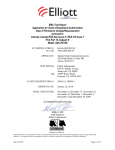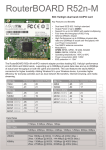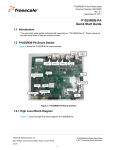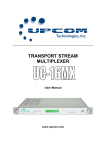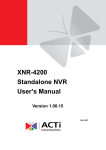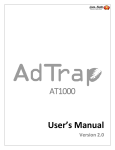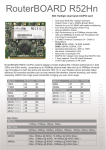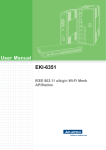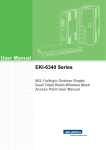Download KMR Series Outdoor AP/Bridge User Manual
Transcript
ST5801GB Series Outdoor AP/Bridge User Manual Kareem Contents Chapter 1: Product Overview.............................. 3 Introduction.......................................................... 3 Installation............................................................ 3 Package Contents..................................................4 Chapter 2: System Configuration........................ 5 System Setup.........................................................5 System Setup > Basic Setup................................. 5 System Setup > Network Setup........................... 6 Wireless.................................................................7 Wireless > Radio Setup........................................ 7 Wireless > WLAN Setup....................................... 7 Wireless > Wireless Security............................... 8 Wireless > WMM Setup........................................ 9 Wireless > Bandwidth Control.......................... 10 Administration................................................... 10 Administration > Management......................... 10 Administration > Login Password.................... 11 Administration > SNMP Setup...........................11 Utility...................................................................12 Utility > Ping....................................................... 12 Utility > RSSI Calculator.....................................12 Utility > Fresnel Zone.........................................12 Utility > Antenna Alignment Tool..................... 12 Utility > Site Survey............................................13 Status................................................................... 13 Status > System Information............................. 13 Status > System Status....................................... 13 Status > Connecting Nodes Information...........14 Status > Connecting AP Information.................14 Appendix 1: Specifications.................................15 Hardware Specification..................................... 15 Software Specification....................................... 18 2 Chapter 1: Product Overview Introduction integrated with central RADIUS server and data encryption technique, the ST5801GB SERIES OUTDOOR AP/BRIDGE series provide a secure wireless connectivity for each client device. The ST5801GB SERIES OUTDOOR AP/BRIDGE series are enterprise and carrier-grade 802.11N Outdoor Wireless Access Point which offers customer a robust and high performing solution for PTP/PTMP/Hotzone applications in both license-free 2.4GHz and 5GHz bands. The ST5801GB03R is the most ideal candidate for Service Providers looking to deliver carrier-grade wireless services to multiple market segments such as campuses, hospitality, healthcare, warehousing and wider metropolitan area deployments. Designed to meet customer needs in a broad range of industries, the ST5801GB SERIES OUTDOOR AP/BRIDGE offer the following benefits : ST5801GB SERIES OUTDOOR AP/BRIDGE Category Model Radio Spec. Radio Amount ST5801GB01R Dual-Band 2x2 MIMO Normal Power 1 ST5801GB02R Dual-Band 2x2 MIMO Normal Power 2 ST5801GB03R Dual-Band 2x2 MIMO Normal Power 3 ST5801GB01R H Dual-Band 2x2 MIMO High Power 1 ST5801GB02R H Dual-Band 2x2 MIMO High Power 2 Flexible wireless backbone deployment options Multiple radio interfaces were integrated by FonSee’s core data switching technology inside the ST5801GB SERIES OUTDOOR AP/BRIDGE series. Each radio interface can be configured independently to meet different wireless connectivity purposes. With the fast data switching between multiple radio ST5801GB03R H Dual-Band 2x2 MIMO High Power 3 interfaces, the backbone throughput will remain in a high level even after several relays between APs. interfaces. Each 2X2 MIMO radio interface will has 2 N-type connectors come out on the waterproof housing. We strongly recommend that check antenna attachment to match your configuration before the installation. High-performance wireless backbone With the next generation 802.11N MIMO technology, the ST5801GB SERIES OUTDOOR AP/BRIDGE offer data link rate up to 300Mbps in each single radio interface. Short Guard Interval and Frames Aggregation methodology configurations improve the efficient of backbone usage. Installation The ST5801GB SERIES OUTDOOR AP/BRIDGE series product has up to 3 dual-band 2X2 MIMO radio Secure and efficient client connectivity The nimble QoS (Quality of Service) configuration provides flexible management of user’s access bandwidth of wireless connectivity. Perfect 3 Package Contents A PoE is the power supply of the ST5801GB SERIES OUTDOOR AP/BRIDGE series. Please connect the ETH1+Power port to the included PoE injector by Ethernet cable. ● ST5801GB SERIES OUTDOOR AP/BRIDGE 802.11A/G/N Outdoor Wireless Bridge ● PoE Power Injector ● Power Adapter ● Mounting Kit & Screw ● CD: User Manual Connect another data port on the PoE injector to your LAN switch or PC, if necessary. 4 Chapter 2: System Configuration Access the Browser-Based Utility System Setup To access the system web user’s interface, launch the web browser on your computer, and enter the device IP address in the Address field of the web browser. (The factory default IP address is 192.168.1.1.) Then press Enter. A System Setup includes device related elements, such as system time and IP setting. A login screen will appear. Go to the login page by Click the “Home > Login” in sub-menu. Login ID and password is required before access the system web user’s interface. The default administrator’s ID is admin and password is admin. For normal user’s login ID is user and password is user. Configuration will be not available for user account. System Setup > Basic Setup Language The ST5801GB SERIES OUTDOOR AP/BRIDGE series WEB GUI is designed to support English language in display. Users can choose the proper language in language list. Device Name User would like to give a name for identifying a particular outdoor access point in here. The configuration page was vertically divided into right and left part. Items in the left part show the concurrent configuration corresponds to the items in right part. System Date User would like to set the date manually in this item. System Time User would like to set the time manually in this item. Please do remember to click the Apply button on the very bottom of every page to make your configuration changes effected; otherwise the changes you just made will be ignored once you Time Synchronization Time synchronization setting will decide the duration to next time synchronization. When any NTP server is available in network, user can enable the NTP and system will automatically leave the current page. You can also click the Cancel button to regret the changes. synchronize system time with NTP server. GMT Time zone Set a Greenwich Mean Time setup 5 for time synchronization. Time Server User can insert an available IP address of NTP server in Internet for time synchronization. System Setup > Network Setup IP Setup STP The Spanning Tree Protocol (STP) is a network protocol that ensures a loop-free topology for any bridged Ethernet local area network. The basic function of STP is to prevent bridge loops and ensuing broadcast radiation. Spanning tree also allows a network design to include spare (redundant) links to provide automatic backup paths if an active link fails, without the danger of bridge loops, or the need for manual enabling/disabling of these backup links. Ethernet Link Speed IP Assignment System allows you to assign the device IP address dynamically from existing DHCP server or set a static IP address manually. IP Address Once Static IP was selected, the IP Address field will allow you to set the bridge device IP address manually. This IP address of the bridge is used as the base for all of your local network settings. Link The link speed of Ethernet port can be changed manually into 10/100 Half/Full duplex. DHCP Server Setting The ST5801GB SERIES OUTDOOR AP/BRIDGE series can be configured as a DHCP server for a LAN network. Once the DHCP Server is chose as on, the DHCP server setting elements will spread out on the page. Subnet Mask This is the subnet mask address for your bridge device. Set the IP subnet mask manually. Default Gateway Set the default gateway IP address manually. DNS 1 & 2 The Domain Name System (DNS) is how the Internet translates domain or website names into Internet addresses or URLs. Your ISP will provide you with at least one DNS Server IP Address. If you wish to use another, enter that IP Address in DNS 2 field. DHCP Server Allows you to enable or disable the DHCP server function in system. IP Start / End The IP Start and End Address specify the range of addresses assigned by your device when it functions as a DHCP server. Spanning Tree Protocol Primary & Secondary DNS Set the primary and 6 secondary DNS server IP address which DHCP server is going to assign for DHCP client devices. Default Gateway Default gateways IP address assign for DHCP client devices. Management VLAN Management VLAN Management VLAN is a secure VLAN which divides Internet users from device IP access. Administrators can management network devices under the Management LAN network without betrayal of secrets. Wireless Wireless > Radio Setup Channel Available channel will relate to what wireless band is chosen. Transmission Power Control the transmit power of a radio by selection of Transmission Power. Antenna Number ST5801GB SERIES OUTDOOR AP/BRIDGE series complete 802.11n 1x1 1-steram and 2x2 2-stream for antenna attached. The maximum data link rate at 1-steram and 2-stream will be 130Mbps and 300Mbps. Short Guard Interval The guard interval is the space Wireless Band Choose a radio frequency for signal transmission. The frequency and channel bandwidth match to selection is showed as following table: between symbols (characters) being transmitted. Adding time between symbol transmissions allows these echoes and reflections to settle in before the next symbol is transmitted. In normal 802.11 operations, the guard interval is 800 ns. A short guard interval will short the time between symbol transmissions into 400 ns to enhance the efficiency of data transmission. Aggregation Frame aggregation is a feature of the 802.11n wireless LAN standards that increases throughput by sending two or more data frames in a single transmission. Distance To assign a distance between nodes in a 7 point to point transmission will improve the success rate of data transmit. Wireless > WLAN Setup Each physical radio interface supports up to 16 virtual WLAN AP setting. User can add or delete a virtual AP by click the “+” or “-” button on top of the very right side of setting block. SSID A service set identifier (SSID) is a name that identifies a particular 802.11 wireless LAN. A client device receives beacon messages from all access points within range advertising their SSIDs. The client device can then either manually or automatically select the network with which to associate. Broadcast Network administrator can choose broadcast beacon messages of a virtual AP by checking the broadcast block. RTS “Request to send” is the optional mechanism used by the 802.11 wireless networking protocol to reduce frame collisions introduced by the hidden node problem. Set the packet size to trigger RTS/CTS enable. This is normally set in AC side only because the hidden station problem does not exit from the perspective of the AP. RTS Threshold can be set between 1 and 2312 bytes. Fragmentation Set the packet size to activate fragmentation. Fragmentation threshold can be set between 1 and 2312 bytes. Note: Fragmentation setting will be automatically disabled, once the frame aggregation is enabled. Limited Data Rate Limit the wireless data link rate to enhance the stability of data transmission. VLAN ID In order to create a wireless VLAN environment, each virtual AP can conform to an 802.1q VLAN tag ID. VLAN Priority Each VLAN ID can be gave a priority number (from 0 to 7) for data process priority. Client Numbers Limit the maximum number of associate client devices. Client Isolation Client isolation will protect the privacy of each connecting client from searching in a wireless LAN. Enable Network administrator can also decide functioning of virtual AP or let it idle. WLAN Mode Radios support “Access Point”, “Wireless Station”, “Access Point (WDS Support)” Bandwidth Profile Choose a bandwidth control profile for virtual AP interface. (About the detail of bandwidth profile, please refer to the bandwidth control setup in coming pages.) Wireless > Wireless Security and “Wireless Station (WDS Support)” mode to meet various network scenarios. 8 of WEP key as shown in the table are entered. Note that in HEX format, HEX number cannot start with “0”. SSID User can choose a specific virtual AP to assign a security type of wireless link. MAC Filter MAC filter provides allow or deny MAC table for administrator to access control of AP by insert a MAC address of client device. When running allow mode, only the MAC address which showing on the table will be accept for wireless connectivity. When running deny mode, MAC address which showing on the table will be blocked from wireless connectivity. The table can be configured 32 MAC address at most of each virtual AP interface. Number of digit/character ASCII HEX 64-bit 5 10 128-bit 13 26 152-bit 16 32 WPA+WPA2-PSK ST5801GB SERIES OUTDOOR AP/BRIDGE series support WPA+WPA2-PSK (WPA-Personal) in security. WPA+WPA2-PSK (Pre-shared key) mode is designed for home and small office networks and doesn't require an authentication server. Each wireless network device authenticates with the access point using the same 256-bit key. TKIP Temporal Key Integrity Protocol: A 128-bit per-packet key is used, meaning that it dynamically generates a new key for each packet. Used by WPA. CCMP An AES-based encryption mechanism that is stronger than TKIP. Sometimes referred to as AES instead of CCMP. Used by WPA2. Both TKIP and CCMP encryption are available for WPA+WPA2-PSK. Pre-shared key of 8 to 63 characters are required. Group Rekey Interval can be set up to 65536 seconds. Wireless > WMM Setup Security Comprehensive security settings are available on system in this menu. These include WEP Keys and WPA+WPA2-PSK. Details of each type of security are in appendix. The security settings are independent between each virtual AP interface. WEP System supports 64-bit, 128-bit and 152-bit WEP key in both ASCII and HEX format. Do make sure the correctly number of digits/characters and format Wi-Fi Multimedia (WMM) is a Wi-Fi Alliance interoperability certification, based on the IEEE 9 802.11e standard. It provides basic Quality of service (QoS) features to IEEE 802.11 networks. WMM prioritizes traffic according to four Access Categories (AC) - voice, video, best effort, and background. It is suitable for simple applications that require QoS, such as Voice over IP (VoIP) on Wi-Fi phones (VoWLAN). 10 Administration Wireless > Bandwidth Control ST5801GB SERIES OUTDOOR AP/BRIDGE series provide system management in menu partition: Administration, Which includes configuration file management, password maintaining and SNMP setup. Administration > Management Profile ID There are 20 bandwidth control profiles can be configured for administration. Mode Downstream and upstream data rates for subscriber or the client devices connecting to AP can be defined here. There are two bandwidth limit types in system. Both mode (UL+DL Limit Rate) consolidates download and upload rate of each single client connection. UL/DL mode (UL/DL Limit Rate) specifies download and upload rate of client connections. Once the bandwidth limit is enabled, the limitation applies to all clients that connect to the AP. Firmware Upgrade Administrator can upload a new firmware file to device to keep system running by the latest bug fixed version of firmware. Configuration Management Administrator would like to save the configuration of device to local PC by click “Backup Configuration”. Once hardware damage happened, administrator can restore a saved configuration file to a new hardware without any reconfiguration. “Reset Default” allows administrator to reload the system to factory default. System Restart Click the “System Reboot” button will help to warm start the system. 11 Administration > Login Password SNMP V3 System allows administrator to change the “admin” and “user” login password in menu partition: “Login Password”. Administration > SNMP Setup RW User Name Read and write authority login ID. RW User Password Read and write authority login password. RO User Name Read only authority login ID. ST5801GB SERIES OUTDOOR AP/BRIDGE series support both SNMP V2 and V3. The configurable items show below: System Location A description notes the device location. System Contact A description notes the device maintaining information. RO User Password Read only authority login password. AUTH method Choose the user authentication method. ENC method Choose the SNMP data encryption method. SNMP V2C System Name A description notes the given name of device. RW Community Read community stream. and write authority RO Community Read only authority community stream. 12 Utility Utility > Fresnel Zone ST5801GB SERIES OUTDOOR AP/BRIDGE series provide various software utilities helping administrator to do the network status survey. Utility > Ping The First Fresnel Zone Calculator is a tool that helps you to estimate the possible obstruction from existing object between two devices before the wireless installation. An antenna angle calculation can also help you to aligning the vertical angle of the directional antenna. Graphical display helps administrator to get the responding time changes of target IP address. Insert the remote host IP address, packet size and number in field than press Ping, system will show the result on page. The result presenting can be adjusted by different choosing of graphic scale. Utility > RSSI Calculator Utility > Antenna Alignment Tool In order to lift efficiency of antenna aligning, AMP-100R(H) series provide a software alignment tool helping the installers to align and check the antenna directions. Antenna Alignment Tool will require triggering the function both access point and wireless station (AP Client) side. It means that both access point and wireless station (AP Client) side should be the ST5801GB SERIES OUTDOOR AP/BRIDGE series product, otherwise, the function doesn’t get properly use. Simple RSSI Calculator helps to estimate a possible RSSI and path loss by known device Tx power (transmission power), cable loss, antenna gain and frequency both transmitting and receiving side. Graphic displaying shows changes of path loss and RSSI. Choose the SSID which you are going to do the 13 antenna aligning and click the Star button both access point and wireless station (AP Client) side to start the antenna alignment. You will able to see the RSSI changes in figure. Try to adjust the directional antenna’s horizontal and vertical angle to get the best RSSI level. Link Test A Link Test is additional tool base on Antenna Alignment Tool active status. When you start the Antenna Alignment Tool, you may set a target throughput to active the Link Test to estimate the packet error rate. Choose a target throughput and test duration than click Start Test button. System will generate a test data transmission to calculate the packet error rate. Status Status > System Information System Information summarizes all the configuration and hardware information of the device. Status > System Status An Rx rate shows the best data rate you can reach under the current RSSI level. Link Test Tool can also help you to do the fine tuning of your antenna direction. Utility > Site Survey Real-time link statuses of all interfaces are shown in the menu. In wireless site survey, system provides a signal scan function to detect any available wireless signal around the AP. It will help AP installer to clarify the environment. Choose a radio interface which you are going to do the survey on device and click Scan button. After few seconds, system will show the APs around the device. System Up Time Display how long ST5801GB SERIES OUTDOOR AP/BRIDGE has been operating since last boot-up. Interface Status Indicate the interface is ENABLE or DISABLE. Link Rate Data Link Rate here indicates the maximum transmission rate available, and can be 14 used as an indication of link quality. Link Quality A Calculation of RSSI, signal and noise level to indicate the quality of the communication link in percentage. Channel The channel used by the wireless interface. Graphic display is also available for observing the changes. Signal Level A -70 ~ -50dBm signal level is recommended for a good connection. Too low a signal, the wireless link between AP and AC cannot be established. Too high a signal level, the power amplifier at the receiver might be forced to operate in saturation region and distorts the signal waveform. Status > Connecting AP Information In order to help user’s reading of the changes, system also provide a graphic interface to trace the items’ changes. Click the Graphic Display button on the top left of the page, graphic mode will show on your browser. In the “Connecting AP Information” page, RSSI, Rx rate, Tx rate and etc. are provided for verification of wireless link status. Graphic display is also available for observing the changes. Status > Connecting Nodes Information All the connecting clients’ MAC address will be display in Connecting Nodes Information, including signal and data rate. The result shows information only when WLAN was configured as Access Point mode. 15 Appendix 1: Specifications Hardware Specification System Overall Peripheral Main Processor Atheros AR7161(680Mhz) Wireless Chipset Atheros AR9220 based miniPCI module, Up to three modules Switch Controller Atheros AR8035 / Atheros AR8021 Flash Memory 16MBytes SDRAM 64MBytes(Up to 128MBytes) Console UART x 1(PCBA onboard) RTC Onboard RTC PoE 48V 1A PoE Ethernet Gigabit Speed Support Wireless Up to three 2x2 MIMO radios, mini-PCI version 1.0 type 3A Frequency ranges : a. USA : 2.400 ~ 2.483 GHz, 5.15 ~ 5.35 GHz, 5.5 ~ 5.7 GHz, 5.725 ~ 5.825 GHz b. Europe: 2.400 ~ 2.483 GHz, 5.15 ~ 5.35 GHz, 5.47 ~ 5.725 GHz c. Japan: 2.400 ~ 2.497 GHz, 5.15 ~ 5.35 GHz, 5.47 ~ 5.725 GHz d. China: 2.400 ~ 2.483 GHz, 5.725 ~5.85 GHz RF ourput power of DNMA-92 : a. IEEE802.11a 1. 21dBm@6M(all) 2. 17dBm@54M(5180MHz) 16dBm@54M(5825MHz) b. IEEE802.11b 1. 20dBm@1M(2412MHz) 19dBm@1M(2484MHz) 2. 21dBm@11M(all) c. IEEE802.11g 1. 23dBm@6M(all) 2. 19dBm@54M(all) d. IEEE802.11a/n HT20 1. 21dBm@MCS0/8(5180MH z) 19dBm@MCS0/8(5825M Hz) 2. 16dBm@MCS7/15(5180M Hz) 16 14dBm@MCS7/15(5825 MHz) e. IEEE802.11a/n HT40 1. 19dBm@MCS0/8(5190MH z) 18dBm@MCS0/8(5795M Hz) 2. 13dBm@MCS7/15(all) f. IEEE802.11g/n HT20 1. 21dBm@MCS0/8(all) 2. 17dBm@MCS7/15(all) g. IEEE802.11g/n HT40 1. 21dBm@MCS0/8(2422MH z) 20dBm@MCS0/8(2462M Hz) 2. 16dBm@MCS7/15(all) Receive Sensitivity of DNMA-92 : a. IEEE802.11a 1. -82dBm@6M, 1Rx -95/-91dBm@6M, 2Rx 2. -65dBm@54M, 1Rx -79/-75dBm@54M, 2Rx b. IEEE802.11b 1. -82dBm@1M, 1Rx -95/-91dBm@1M, 2Rx 2. -76dBm@11M, 1Rx -91/-87dBm@11M, 2Rx c. IEEE802.11g 1. -82dBm@6M, 1Rx -95/-91dBm@6M, 2Rx 2. -65dBm@54M, 1Rx -80/-76dBm@54M, 2Rx d. IEEE802.11a/n HT20 1. -82dBm@MCS0, 1Rx -95/-91dBm@MCS0, 2Rx 2. -64dBm@MCS7, 1Rx -77/-73dBm@MCS7, 2Rx e. IEEE802.11a/n HT40 1. -79dBm@MCS0, 1Rx -91/-87dBm@MCS0, 2Rx 2. -61dBm@MCS7, 1Rx -74/-70dBm@MCS7, 2Rx f. IEEE802.11g/n HT20 1. -82dBm@MCS0, 1Rx -95/-91dBm@MCS0, 2Rx 2. -64dBm@MCS7, 1Rx -77/-73dBm@MCS7, 2Rx g. IEEE802.11g/n HT40 1. -79dBm@MCS0, 1Rx -90/-86dBm@MCS0, 2Rx 2. -61dBm@MCS7, 1Rx -74/-71dBm@MCS7, 2Rx RF output power of DNMA-H92 : a. IEEE802.11a 1. 24dBm@6M(all) 2. 21dBm@54M(all) b. IEEE802.11b 1. 24dBm@1M(all) 2. 24dBm@11M(all) c. IEEE802.11g 1. 25dBm@6M(all) 2. 22dBm@54M(all) d. IEEE802.11a/n HT20 1. 24dBm@MCS0/8(all) 2. 18dBm@MCS7/15(5180M Hz) 17dBm@MCS7/15(5825 MHz) e. IEEE802.11a/n HT40 1. 22dBm@MCS0/8(all) 2. 17dBm@MCS7/15(5190M Hz) 17 16dBm@MCS7/15(5795 MHz) -95/-91dBm@MCS0, 2Rx 2. f. IEEE802.11g/n HT20 -77/-73dBm@MCS7, 2Rx 1. 25dBm@MCS0/8(all) g. IEEE802.11g/n HT40 2. 21dBm@MCS7/15(all) 1. g. IEEE802.11g/n HT40 2. 2. 20dBm@MCS7/15(all) Ethernet 10/100/1000 Base-TX MDI/MDIX RJ-45 x 1 -82dBm@6M, 1Rx -95/-91dBm@6M, 2Rx 2. Compliant with : -65dBm@54M, 1Rx a. IEEE802.3 / 802.3u / 802.3at -79/-75dBm@54M, 2Rx b. Hardware based 10/100/1000, full/half, flow control auto negotiation b. IEEE802.11b 1. -82dBm@1M, 1Rx -92/-88dBm@1M, 2Rx 2. c. IEEE802.11g -82dBm@6M, 1Rx -95/-91dBm@6M, 2Rx 2. -65dBm@54M, 1Rx -80/-76dBm@54M, 2Rx d. IEEE802.11a/n HT20 1. Connector 2 x N-type(1 radio) 4 x N-type(2 radios) 6 x N-type(3 radios) Power Requirement 48V 1A PoE Support Gigabit Ethernet Link Watch Dog Hardware Watch Dog -76dBm@11M, 1Rx -92/-88dBm@11M, 2Rx 1. -61dBm@MCS7, 1Rx -74/-70dBm@MCS7, 2Rx a. IEEE802.11a 1. -79dBm@MCS0, 1Rx -92/-88dBm@MCS0, 2Rx 1. 24dBm@MCS0/8(all) Receive Sensitivity of DNMA-H92 : -64dBm@MCS7, 1Rx -82dBm@MCS0, 1Rx Physical Dimensions 220 x 220 x 77 mm Weight 2.0kg(3.7kg mount kit included) Water and Dust Proof Outdoor IP67 rated -95/-91dBm@MCS0, 2Rx 2. -64dBm@MCS7, 1Rx -77/-73dBm@MCS7, 2Rx e. IEEE802.11a/n HT40 1. Environmental Temperature Range -20 ~ 70°C Humidity 0~95% -79dBm@MCS0, 1Rx -91/-87dBm@MCS0, 2Rx 2. -61dBm@MCS7, 1Rx -73/-69dBm@MCS7, 2Rx f. IEEE802.11g/n HT20 1. -82dBm@MCS0, 1Rx 18 Software Specification System Operation Performance Layer 2 Switching Learning Technology TCP Store-and-Forward Bridge Mode Spanning Tree Protocol - IEEE 802.1d STP / IEEE 802.1w RSTP Static IP DHCP server / client IEEE 802.1q Tag VLAN Wireless UDP To Wire IEEE 802.1p VLAN Priority Based QoS PPS Network Interface Up to 180Mbps for one radio to Ethernet Up to 320Mbps for multiple radios to Ethernet Up to 240Mbps for one radio to Ethernet Up to 350Mbps for multiple radios to Ethernet >= 20,000@short packet for one radio to Ethernet >= 28,000@short packet for multiple radios to Ethernet IEEE 802.11 a/b/g/n 2.4GHz / 5GHz Dual Band Radio Latency < 5ms 2 hops Up to 160Mbps 2 x 2 MIMO Technology 3 hops Up to 150Mbps >= 4hops Up to 140Mbps PPS >= 20,000@short packet at multiple hops Latency < 10ms Single Radio / Dual Radios / Triple Radios Multiple Hops AP mode / Client mode WDS Support enable / disable IEEE 802.11h DFS Wireless WMM QoS Security Channel / Tx Power / Data Rate / Hide SSID(turn off ESSID broadcasting) Max Distance Adjustable MAC Address ACL Multi-SSIDs / VLAN tags mapping(Up to 16 x ESSIDs for each radio) WEP 64/128/152 bits Wireless Site Survey WPA / WPA2 PSK / EAP with TKIP / CCMP AES based Encryption Node Information IEEE 802.1x EAP-MD5 / EAP-TLS / EAP-TTLS Concurrent Connected Node Limitation Client User Isolation 48V 1A PoE Support Gigabit Ethernet Speed Wire Ethernet Link Speed Configurable 10/100/1000 Base-TX MDI/MDIX RJ-45 19 Management Advanced Technology HTTP(s) WEB GUI Telnet Up to 10 hops with more than 120Mbps throughput Multiple Hopping Configurable Max. Hop Counts(default 20 hops) SSH Console(optional interface) CLI commands Advanced Features Wireless Bandwidth Limitation SNMP v2c/v3, standard / private MIBs Syslog Management VLAN Tag NTP Client Firmware upgrade / downgrade Dual Images Dual Configuration files / Factory Default Multiple Level Management 20























